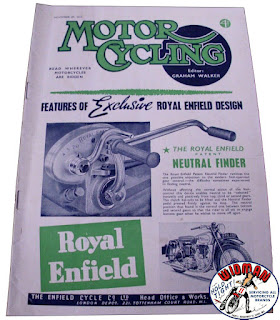 |
| A 1947 ad explains why Royal Enfields got a neutral finder. |
There's a very old joke about old Royal Enfield motorcycles: "Royal Enfield is the only motorcycle in the world with a 'neutral finder' lever, and the only motorcycle in the world that needs one."
The joke is about the balky old four-speed Albion gearbox that served Royal Enfield motorcycles up to the introduction of a much slicker five-speed gearbox in the current century.
In 1946 the four-speed got an added heel-operated lever that takes it from any upper gear directly to neutral. The neutral finder lever is a real convenience in the four-speed, and using it forms a basic part of my riding on my 1999 Royal Enfield Bullet.
But how, really, did the neutral finder lever find its way onto the Royal Enfield gearbox?
I about fell out of my chair when I recently came across an eBay ad by Widman Motorcycle Service for a 1947 copy of Motor Cycling magazine. There, on the front cover, was a Royal Enfield ad touting "The Royal Enfield Patent Neutral Finder."
It was patented, alright, but not by Royal Enfield. Albion Engineering, designer (and, I presume maker) of the gearbox used on Royal Enfields had patented the neutral finder device in 1944.
Royal Enfield historian Gordon May fully explains the point of the neutral finder in his on-line article "Finding Neutral." He even reproduces a period advertisement that points out that "This exclusive feature is particularly advantageous to those unfamiliar with foot shifting..."
What does foot shifting have to do with it? Gordon explains:
"In the 1920s and 1930s, nearly all motorcycle gearboxes were operated by a hand change lever that was attached to the side of the petrol tank. This meant that the rider had to take his hand off the throttle and away from the brake lever every time he wanted to change gear – a huge disadvantage. Royal Enfield outsourced its gearbox design and manufacture to Albion, a Birmingham-based engineering firm that met the gearbox needs of many British and European motorcycle manufacturers. Albion positive-stop footchange gearboxes were first fitted to Royal Enfields in 1932 and were a major drawcard for the new, top-of-the-range Bullet models.
"However, their design was an adaptation of their existing hand change gearboxes and although Albion gearboxes were well engineered and hard wearing, they were also quite clunky. When stationary, the foot-operated unit could be tricky to operate and it was often hard to find neutral, especially at the beginning and end of its serviceable life. The neutral selector overcame this issue, simply and cleverly, and was especially convenient for riders who rode frequently in stop-start town or city traffic."
OK, I think I get it: a rider using a hand shift could rattle the lever around until he massaged the gearbox into neutral. But you couldn't do this by stomping on a lever with your foot – until the separate, foot-operated neutral finder lever was added.
What didn't strike me at first was that, well, Royal Enfield could hardly market motorcycles by admitting that the gearbox is so bad you need this extra gizmo to make it work, could they?
The 1946 advertisement I spotted on the front of Motor Cycling magazine shows how they did just that. It states:
"The Royal Enfield Patent Neutral Finder removes the one possible objection to the modern foot operated gear control – the difficulty sometimes experienced in finding neutral."
And so it does! In modern terms, Royal Enfield turned a "bug" into a "feature."

























http://myroyalenfields.blogspot.com/2009/05/neutral-finder.html
ReplyDelete